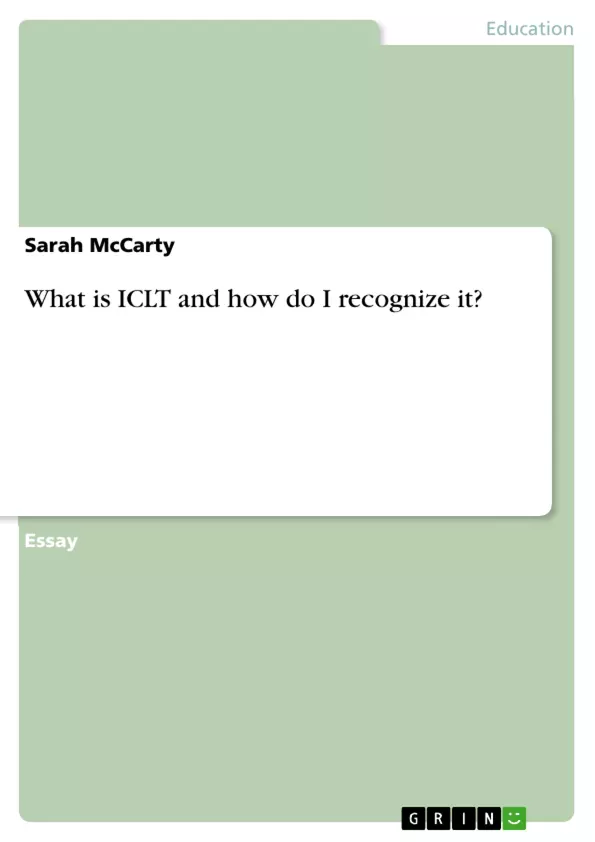Die vorliegende Hausarbeit beschäftigt sich mit dem Thema Interkulturelle Kommunikative Kompetenz. In den Ausführungen wird zunächst eine Definition gegeben und anschließend dargelegt, was die Ziele dieses Ansatzes sind, inwiefern er im schulischen Kontext umgesetzt wird und welche Chancen und Grenzen er bietet. Ferner wird darauf eingegangen, warum dieser Ansatz in einem erfolgreichen Fremdsprachenunterricht nicht fehlen darf und was geschieht, wenn der Unterricht nicht nach diesem Ansatz strukturiert ist. Insgesamt wird in dieser Hausarbeit aufgezeigt, dass Interkulturelles Lernen und die Kommunikative Kompetenz untrennbar sind und als Grundlage für den Englischunterricht dienen müssen. Nur so können Schüler das Gelernte auch außerhalb des schulischen Kontexts anwenden, was grundsätzlich Ziel eines jeden Unterrichts sein sollte.
Inhaltsverzeichnis (Table of Contents)
- Reference List
- Essay
Zielsetzung und Themenschwerpunkte (Objectives and Key Themes)
This essay examines the application of Intercultural Communicative Language Teaching (ICLT) in English language classrooms. It explores the shortcomings of traditional rote learning methods and argues for a more communicative approach that emphasizes meaningful contexts and authentic materials.
- Effectiveness of ICLT compared to traditional methods
- Importance of meaningful contexts and authentic materials in language acquisition
- Role of student participation and risk-taking in language learning
- Challenges in implementing ICLT in the classroom setting
- The significance of real-world applications in language learning
Zusammenfassung der Kapitel (Chapter Summaries)
Essay: This essay explores the limitations of traditional English language teaching methods that prioritize grammatical correctness over communicative competence. It argues that rote memorization of sentences without contextual understanding hinders genuine language acquisition. The author contrasts this approach with Intercultural Communicative Language Teaching (ICLT), emphasizing the importance of meaningful tasks, authentic materials, and active student participation. The essay uses the author's personal experience as a student to illustrate the positive impact of communicative activities, such as planning a student exchange program, on language learning. It highlights the importance of encouraging risk-taking and fluency over perfect grammatical accuracy, acknowledging the challenges of implementing ICLT in real-world classroom settings but stressing its potential to foster more engaging and effective language learning. The author concludes by emphasizing the importance of making language learning meaningful and relevant to students' lives.
Schlüsselwörter (Keywords)
Intercultural Communicative Language Teaching (ICLT), communicative language teaching, authentic materials, contextualized learning, fluency, accuracy, student participation, language acquisition, real-world applications, classroom challenges.
Frequently Asked Questions: Language Preview
What is the overall topic of this language preview?
This language preview provides a comprehensive overview of an essay examining the application of Intercultural Communicative Language Teaching (ICLT) in English language classrooms. It contrasts ICLT with traditional rote learning methods, highlighting the benefits of a communicative approach focused on meaningful contexts and authentic materials.
What are the key themes explored in the essay?
The key themes include the effectiveness of ICLT compared to traditional methods; the importance of meaningful contexts and authentic materials; the role of student participation and risk-taking; challenges in implementing ICLT; and the significance of real-world applications in language learning.
What are the main arguments presented in the essay?
The essay argues that traditional methods, prioritizing grammatical correctness over communicative competence, hinder genuine language acquisition. It advocates for ICLT, emphasizing meaningful tasks, authentic materials, and active student participation to foster more engaging and effective language learning. The essay highlights the importance of fluency over perfect grammatical accuracy and the need to make language learning relevant to students' lives.
What teaching methods are compared in the essay?
The essay compares Intercultural Communicative Language Teaching (ICLT) with traditional rote learning methods. It criticizes the latter for its focus on memorization without contextual understanding and contrasts it with ICLT's emphasis on communicative competence and real-world applications.
What is the role of authentic materials and meaningful contexts in the essay's argument?
The essay strongly advocates for the use of authentic materials and meaningful contexts in language learning. It argues that these elements are crucial for fostering genuine understanding and communicative competence, unlike traditional methods that often rely on isolated grammatical exercises.
What are the challenges of implementing ICLT discussed in the essay?
The essay acknowledges the challenges of implementing ICLT in real-world classroom settings, but ultimately emphasizes its potential to create a more engaging and effective learning environment.
What examples are used to illustrate the benefits of ICLT?
The essay uses the author's personal experience as a student to illustrate the positive impact of communicative activities, such as planning a student exchange program, on language learning.
What are the keywords associated with this essay?
The keywords include: Intercultural Communicative Language Teaching (ICLT), communicative language teaching, authentic materials, contextualized learning, fluency, accuracy, student participation, language acquisition, real-world applications, and classroom challenges.
What is included in the language preview itself?
The language preview includes a table of contents, objectives and key themes, chapter summaries (in this case, an essay summary), and keywords.
- Quote paper
- Sarah McCarty (Author), 2008, What is ICLT and how do I recognize it?, Munich, GRIN Verlag, https://www.grin.com/document/160930



